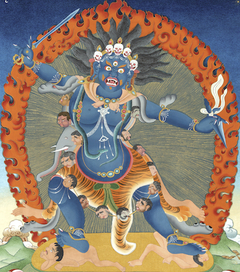Introduction to Vajraṇakhī
Introduction to Vajraṇakhī
by Stefan Mang
Vajraṇakhī[1] (rdo rje sder mo), or 'Vajra Claw', is a wrathful ḍākinī whose mantra appears in various forms in, for example, the Guhyasamāja, Vajravārāhī, and Vajrakīlaya traditions.[2] In such contexts Vajraṇakhī’s mantra is recited as part of a ritual for the liberation of obstacles. Over time and especially within Tibet, Vajraṇakhī became a deity invoked independently as a means to protect a practitioner's domestic space, family, friends and allies and to avert any obstacles that might threaten them.[3]
According to The Incantation of Glorious Vajraṇakhī[4] (dpal rdo rje sder mo’i gzungs), Buddha Śākyamuni revealed Vajraṇakhī's dhāraṇī in a place called the Vajra Palace (rdo rje zom gyi kham) to an assembly of monks and tantric practitioners. There the Buddha advised them that reciting the dhāraṇī would make Vajraṇakhī their guardian and protector and ensure that they obtain abundant qualities and encounter only favourable circumstances.
At the end of the dhāraṇī, Vajraṇakhī recounts how countless aeons ago she took birth as a female practitioner. At that time the buddha Dṛḍha-śūraraṇa-sena-praharaṇa-rāja (dpa’ brtan pa’i mtshon cha’i rgyal po) visited the world and when Vajraṇakhī met him, he placed his hand upon her head and entrusted her with the dhāraṇī. He predicted that if she were to recite the dhāraṇī continuously, in future she would become the deity known as Vajraṇakhī and bring great benefit and happiness to all sentient beings.
The most important text that invokes Vajraṇakhī as an independent deity is The Incantation of Glorious Vajraṇakhī. Although the dhāraṇī is attributed to Buddha Śākyamuni, it is not found in any extant edition of the Kangyur or Tengyur. Nevertheless, the text is independently preserved in various Tibetan dhāraṇī collections.[5] This and other factors[6] suggest that the dhāraṇī is at least partially a Tibetan composition or revelation. In addition, there are several shorter practices composed for daily recitation, such as a condensed form of the long dhāraṇī arranged by Karma Chakme and two short practices arranged by Dudjom Rinpoche and Dilgo Khyentse Rinpoche based on a terma revelation of Chokgyur Dechen Lingpa.
Further Reading
Griffiths, Arlo. “Written traces of the Buddhist past: Mantras and Dhāraṇīs in Indonesian inscriptions.” In Bulletin of the School of Oriental and African Studies, 77, 214: 137-194.
Mayer, Robert and Cantwell, Cathy. “The Dunhuang Phur pa Corpus: A Survey”, in Almogi, Orna, ed. Contributions to Tibetan Buddhist Literature. PIATS 2006: Tibetan Studies: Proceedings of the Eleventh Seminar of the International Association for Tibetan Studies, Königswinter 2006. Beiträge zur Zentralasienforschung 14. Halle: International Institute for Tibetan and Buddhist Studies, 2008: 248-276.
Mayer, Robert and Cantwell, Cathy. Early Tibetan Documents on Phur Pa from Dunhuang. Verlag der Österreichischen Akademie der Wissenschaften, 2008: 84-5.
Sanderson, Alexis. "Atharvavedins in Tantric Territory: The Āngirasakalpa Texts of the Oriya Paippalādins and their Connection with the Trika and the Kālīkula, with critical editions of the Parājapavidhi, the Parāmantravidhi, and the Bhadrakālī-mantravidhiprakarana.” In The Atharvaveda and its Paippalāda Śākhā: Historical and Philological Papers on a Vedic Tradition, edited by Arlo Griffiths and Annette Schmiedchen. Aachen: Shaker Verlag, 2007. Geisteskultur Indiens: Texte und Studien, 11, Indologica Halensis: 195-311.
Version: 1.1-20250225
-
Vajraṇakhī is a reconstruction of the Sanskrit from the Tibetan. ↩
-
Within the Vajrakīla tradition Vajraṇakhī is the consort of Nīladaṇḍa, one of The Ten Wrathful Ones (daśakrodha; khro bo bcu). ↩
-
Mayer and Cantwell 2008, 258-259. ↩
-
Some sections of the Vajraṇakhī dhāraṇī closely resemble the dhāraṇī literature dedicated to the deity Sitātapatrā (Tōh. 590-593). See, for example, the so-called Dukkar Chokdrupma ↩
-
The dhāraṇī is also found as a Tibetan text within a collection of rare Mongolian manuscripts (http://eap.bl.uk/database/results.a4d?projID=EAP031) and among the Kawaguchi Ekai Collection of Tibetan texts brought to Japan (http://124.33.215.236/Database/KawaguchiTop-e.html). ↩
-
Such as the mention of names and places unknown in the broader dhāraṇī literature which do not appear to have an Indian origin; the mismatch between Tibetan and Sanskrit titles; the absence of a translator's colophon; and the mention of a zor, which is a Tibetan ritual item. ↩
